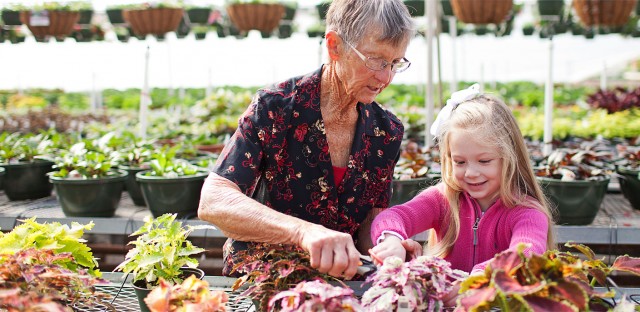Hydrangeas
Welcome to the big blooming world of hydrangeas, another sentimental shrub. The most asked for variety is the “mop”head hydrangea. Its’ botanical name is Hydrangea macrophylla (macro/big, phylla/leaf), also known as the French or Hortensia hydrangeas. They are beautiful pink, blue, & purple clouds of large blooms grown in the shady part of the garden. A north or northeast side of the house is the preferred location. Due to their fondness for moist soil planting under trees is a tough spot for them to thrive. All bloom in the summer, a few are remonstrant (repeat bloomers) & deciduous.

The color can be manipulated by changing the pH of the soil. More alkaline soils cause the blooms to be pink, if the soil is on the acidic side the blooms will be in the blue & purple shades. Hydrangeas grown in containers are much easier to “custom” color than the ones planted in garden soil.

Adding lime, or gypsum, results in blooms in the pink spectrum, on the other hand, adding aluminum sulfate or sulfur will contribute to a more acidic soil & bluer blossoms. In reality it is the absence of aluminum in the growing medium that determines the colors. Hydrangeas grown in pine bark mulch, which is acidic, are pink because there in no aluminum in the pine bark. To add to all this mix keep in mind some hydrangeas are genetically programmed to be pink or white.
Another Hydrangea macrophylla type is picturesquely called a “lacecap”. It resembles the mop cap of colonial days. In the center of the bloom are located many small fertile blossoms that are surrounded by larger, sterile blooms resembling the lace on the cap. It has a flat surface & like the mophead it can be pink and/or blue. The growth habit of this shrub is more graceful while the mophead is upright & a tad stiff looking. Most mature to 4-5 feet wide and as wide.

All hydrangea types enjoy a rich, porous, somewhat moist soil. They are on the thirsty side, as well as hungry, & somewhat demanding. Depending on your soil type they require between an inch & 2 inches of water every week. They need to be protected from late heavy frosts as their buds have already formed for the next blooming season. This makes the one time only bloomers more fragile & if there is an early killing frost in the fall, or a late killing frost in the spring the plant may not bloom that year. Another tragedy resulting in no blooms can be the result of improper pruning, too late the previous year. If properly sited, & cared for the queen of the flowering shrubs will reward you with many blooms in the heat of our humid summers. It often reminds us it needs water by becoming limp & droopy.

The beautiful native, Hydrangea quercefolia, also known as the oakleaf hydrangea (the leaves resemble those on a red oak tree) is a must have. It can take more sun, can be taller, has long panicle shaped blooms (think upside down ice cream cone) of white which turn pink & eventually burgundy as fall rolls around. The leaves turn a deep burgundy color. The stems are a beautiful, cinnamon color, shedding in small shaggy pieces, that adds interest to the winter garden along with the leaves that hang on into the early winter months.
Presently there are many different cultivars in stock at Fariview with many more to arrive closer to bloom time. Keep your eyes open for: Endless Summer/Twist ‘n Shout (a new & improved Endless Summer), Penny Mac, Big Daddy, Nikko Blue, Lady in Red, Pia, Fuji, Mme Emile Mouiillere, Veitchii, BlushingBride, Limelight, Pee Gee, Tardiva, Snow Queen, Pinky Winky, Annabelle, Quickfire, Pee Wee and the climbing H. a. subspecies petiolaris .

One of the prettiest hydrangeas is the climbing hydrangea (Hydrangea anomala). It is very slow starting but once it decides to grow watch it scamper up a tall tree. It comes with built in rootlets to cling vigorously to what ever it is against & is deciduous. I have seen it as high as 20 feet if full bloom in Cary (it can go higher), a striking to say the very least! The blooms are white, 6-10 inches across, of the lace cap form in May & June.
Hydrangeas that thrive in the sun are usually white in color, often fading to pink. H. paniculata, native to China & Japan, is a popular one. Tardiva, Praecox & Pee Gee are prime examples. Pee Gee & Tardiva can be grown as standards, giving the yard a more formal appearance.

Smooth hydrangeas, H. arborescens, are a lesser known hydrangea. The most famous one is ‘Annabelle’. There are many cultivars but none are better known than ‘Annabelle’. The more sun it gets the more compact the bush can be but it is a large shrub by anyone’s opinion. Its’ white global shaped flower heads can measure up to 12”across so you know it will need some space.
Hydrangeas as a rule don’t have many disease or insect problems except for powdery mildew. When hot, wet weather prevails anthracnose can be a problem (circular, irregular brown leaf spots). In the fall a fungal leaf spot (with purple halos) can occur. It is unsightly but not damaging to the plant.
The big buzz in the hydrangea world is the introduction of the reblooming cultivar ‘Endless Summer’ a few years back. A patented plant in the easily recognizable blue container it is developing a big following, not unlike the Knockout Roses. This shrub continues to bloom into the summer & fall as it sets buds throughout the growing season. It is a mophead & can be pink or blue.
Not to be outdone by this reblooming feat there are other hydranges who do the same trick with much less fan fare. ‘Penny Mac’, and ‘Mme Emile Mouillere’ to list just two.




